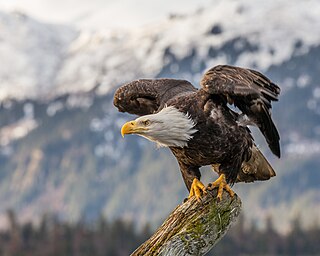
The bald eagle is a bird of prey found in North America. A sea eagle, it has two known subspecies and forms a species pair with the white-tailed eagle, which occupies the same niche as the bald eagle in the Palearctic. Its range includes most of Canada and Alaska, all of the contiguous United States, and northern Mexico. It is found near large bodies of open water with an abundant food supply and old-growth trees for nesting.

Eagle is the common name for the golden eagle, bald eagle, and other birds of prey in the family Accipitridae. Eagles belong to several groups of genera, some of which are closely related. True eagles comprise the genus Aquila. Most of the 68 species of eagles are from Eurasia and Africa. Outside this area, just 14 species can be found—two in North America, nine in Central and South America, and three in Australia.

Haast's eagle is an extinct species of eagle that lived in the South Island of New Zealand, commonly accepted to be the pouākai of Māori mythology. It is the largest eagle known to have existed, with an estimated weight of 15 kilograms, compared to the next-largest and extant harpy eagle, at up to 9 kg (20 lb). Its massive size is explained as an evolutionary response to the size of its prey—the flightless moa—the largest of which could weigh 230 kg (510 lb). Haast's eagle became extinct around 1445, following the arrival of the Māori, who hunted moa to extinction, introduced the Polynesian rat, and destroyed large tracts of forest by fire.

The Accipitridae is one of the three families within the order Accipitriformes, and is a family of small to large birds of prey with strongly hooked bills and variable morphology based on diet. They feed on a range of prey items from insects to medium-sized mammals, with a number feeding on carrion and a few feeding on fruit. The Accipitridae have a cosmopolitan distribution, being found on all the world's continents and a number of oceanic island groups. Some species are migratory. The family contains 255 species which are divided into 70 genera.
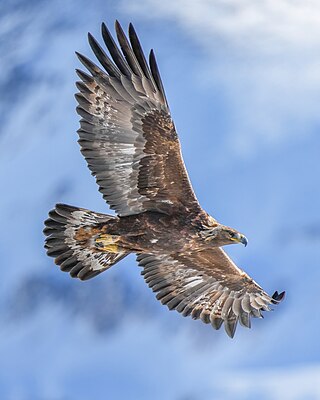
The golden eagle is a bird of prey living in the Northern Hemisphere. It is the most widely distributed species of eagle. Like all eagles, it belongs to the family Accipitridae. They are one of the best-known birds of prey in the Northern Hemisphere. These birds are dark brown, with lighter golden-brown plumage on their napes. Immature eagles of this species typically have white on the tail and often have white markings on the wings. Golden eagles use their agility and speed combined with powerful feet and large, sharp talons to hunt a variety of prey, mainly hares, rabbits, and marmots and other ground squirrels. Golden eagles maintain home ranges or territories that may be as large as 200 km2 (77 sq mi). They build large nests in cliffs and other high places to which they may return for several breeding years. Most breeding activities take place in the spring; they are monogamous and may remain together for several years or possibly for life. Females lay up to four eggs, and then incubate them for six weeks. Typically, one or two young survive to fledge in about three months. These juvenile golden eagles usually attain full independence in the fall, after which they wander widely until establishing a territory for themselves in four to five years.

The osprey, also called sea hawk, river hawk, and fish hawk, is a diurnal, fish-eating bird of prey with a cosmopolitan range. It is a large raptor, reaching more than 60 cm (24 in) in length and 180 cm (71 in) across the wings. It is brown on the upperparts and predominantly greyish on the head and underparts.

The wedge-tailed eagle is the largest bird of prey in the continent of Australia. It is also found in southern New Guinea to the north and is distributed as far south as the state of Tasmania. Adults of the species have long, broad wings, fully feathered legs, an unmistakable wedge-shaped tail, an elongated upper mandible, a strong beak and powerful feet. The wedge-tailed eagle is one of 12 species of large, predominantly dark-coloured booted eagles in the genus Aquila found worldwide. Genetic research has clearly indicated that the wedge-tailed eagle is fairly closely related to other, generally large members of the Aquila genus. A large brown-to-black bird of prey, it has a maximum reported wingspan of 2.84 m and a length of up to 1.06 m.
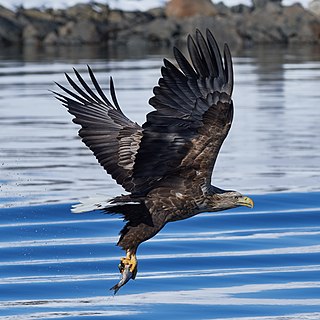
The white-tailed eagle, sometimes known as the 'sea eagle', is a large bird of prey, widely distributed across temperate Eurasia. Like all eagles, it is a member of the family Accipitridae which includes other diurnal raptors such as hawks, kites, and harriers. One of up to eleven members in the genus Haliaeetus, which are commonly called sea eagles, it is also referred to as the white-tailed sea-eagle. Sometimes, it is known as the ern or erne, gray sea eagle and Eurasian sea eagle.

The white-bellied sea eagle, also known as the white-breasted sea eagle, is a large diurnal bird of prey in the family Accipitridae. Originally described by Johann Friedrich Gmelin in 1788, it is closely related to Sanford's sea eagle of the Solomon Islands, and the two are considered a superspecies. A distinctive bird, the adult white-bellied sea eagle has a white head, breast, under-wing coverts and tail. The upper parts are grey and the black under-wing flight feathers contrast with the white coverts. The tail is short and wedge-shaped as in all Haliaeetinae species. Like many raptors, the female is larger than the male, and can measure up to 90 cm (35 in) long with a wingspan of up to 2.2 m (7.2 ft), and weigh 4.5 kg (9.9 lb). Immature birds have brown plumage, which is gradually replaced by white until the age of five or six years. The call is a loud goose-like honking.

The grey-headed fish eagle is a fish-eating bird of prey from South East Asia. It is a large stocky raptor with adults having dark brown upper body, grey head and lighter underbelly and white legs. Juveniles are paler with darker streaking. It is often confused with the lesser fish eagle and the Pallas's fish eagle. The lesser fish eagle is similar in plumage but smaller and the Pallas's fish eagle shares the same habitat and feeding behaviour but is larger with longer wings and darker underparts. Is often called tank eagle in Sri Lanka due to its fondness for irrigation tanks.

Icthyophaga or Ichthyophaga is a genus of six species of eagles, closely related to the sea eagles in the genus Haliaeetus. In fact, some taxonomic authorities place this genus within Haliaeetus. Both are native to southeastern Asia, from the Indian subcontinent southeast to Sulawesi. They are smaller than the Haliaeetus eagles, though overlapping in size with the smaller species of that genus. They share similar plumage, with grey heads grading into dull grey-brown wings and bodies, and white belly and legs. They differ in tail colour, with the lesser fish eagle having a brown tail, and the grey-headed fish eagle having a white tail with a black terminal band, and also in size, with the lesser fish eagle only about half of the weight of the grey-headed fish eagle.
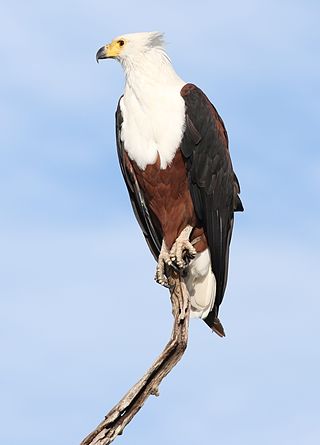
The African fish eagle or the African sea eagle is a large species of eagle found throughout sub-Saharan Africa wherever large bodies of open water with an abundant food supply occur. It is the national bird of Malawi, Namibia, Zambia, and Zimbabwe. As a result of its large range, it is known in many languages. Examples of names include: Vis Arend in Afrikaans, nkwazi in Chewa, aigle pêcheur in French, hungwe in Shona, inkwazi in isiZulu, and ntšhu in Northern Sotho. This species may resemble the bald eagle in appearance; though related, the two species occur on different continents, with the bald eagle being resident in North America.

The Madagascar fish eagle or Madagascar sea-eagle, is a large bird of prey in the family Accipitridae which also includes many other diurnal raptors such as kites, buzzards and harriers. It is endemic to the coastal strip in the northwest of Madagascar. It is about 63 cm (25 in) long and has a pale brown head, dark brown body and white tail. The Madagascar fish eagle has been suffering from a declining population and is threatened by habitat destruction and persecution, and the International Union for Conservation of Nature has rated its conservation status as being "critically endangered".

Steller's sea eagle, also known as Pacific sea eagle or white-shouldered eagle, is a very large diurnal bird of prey in the family Accipitridae. It was described first by Peter Simon Pallas in 1811. No subspecies are recognised. A sturdy eagle, it has dark brown plumage with white wings and tail, a yellow beak, and yellow talons. Typically, it is the heaviest eagle in the world, at about 5 to 10 kg, but in some standard measurements, may be ranked below the harpy eagle and the Philippine eagle. Steller's sea eagle females are bigger than males.
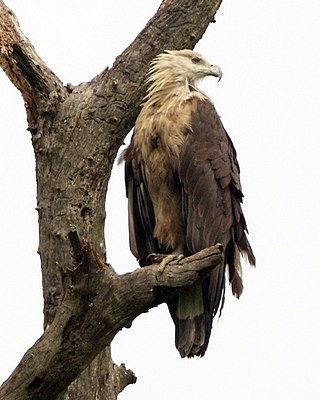
Pallas's fish eagle, also known as Pallas's sea eagle or band-tailed fish eagle, is a large, brownish sea eagle. It breeds in the east Palearctic in Kazakhstan, Russia, Tajikistan, Turkmenistan, Uzbekistan, Mongolia, China, India, Nepal, Bangladesh, Myanmar and Bhutan. It is listed as Endangered on the IUCN Red List. It is partially migratory, with Central Asian birds wintering among the southern Asian birds in northern India, and also further west to the Persian Gulf.

The lesser fish eagle is a species of Icthyophaga found in the Indian subcontinent, primarily in the foothills of the Himalayas, and south-east Asia. There are records from Gujarat, Central India and in more recent times from the Kaveri river valley in southern India, although the south Indian records are now thought to come from an isolated population, disjunct from the species' normal range. Some taxonomic authorities place this species in the monotypic genus Icthyophaga. Others place it in the genus Haliaeetus.
Sanford's sea eagle, also known as Sanford's fish eagle or the Solomon eagle, is a sea eagle endemic to the Solomon Islands archipelago.

Gurney's eagle is a large eagle in the family Accipitridae. It is found in New Guinea and Wallacea, and is an occasional vagrant to Australia.

The eastern osprey is a diurnal, fish-eating bird of prey. They live in Oceania at coastal regions of the Australian continent, the Indonesian islands, New Guinea, and the Philippines. It is usually sedentary and pairs breed at the same nest site, building up a substantial structure on dead trees or limbs. The subspecies resides in a habitat close to coasts and estuaries that provide opportunities for fishing. In 2022, it was considered a defunct species by the IOC, due to its low genetic divergences and absence in morphological differences. The eastern osprey's diet consists mostly of vertebrate fish species. It possesses specialised physical characteristics and exhibits unique behaviour to assist in hunting and catching prey.





















